Common menu bar links
Departmental Performance Report (DPR)
2011-12
Table of Contents
Section I: Organizational Overview
- Raison d'être
- Responsibilities
- Strategic Outcome(s) and Program Activity Architecture (PAA)
- Program Activity Architecture 2011-12
- Organizational Priorities
- Risk Analysis
- Summary of Performance
- Expenditure Profile
- Estimates by Vote
Section II: Analysis of Program Activities by Strategic Outcome
- Strategic Outcome 1.0 People: Highly skilled science and engineering professionals in Canada
- Strategic Outcome 2.0 Discovery: High-quality Canadian-based competitive research in the natural sciences and engineering
- Strategic Outcome 3.0 Innovation: Knowledge and skills in the natural sciences and engineering are transferred to and used productively by the user sector in Canada
Section III: Supplementary Information
Section IV: Other Items of Interest
Minister's Message

The Department of Industry and the other members of the Portfolio have made significant progress on a number of priorities in 2011–12.
This past year, the Industry Portfolio has worked to strengthen Canada's business environment, support scientific research and development, encourage business-driven innovation, and modernize our laws for the digital economy. The Government of Canada has made science, technology and innovation a priority since 2006, and, as this report shows, we are continuing to fulfil our commitment.
The Natural Sciences and Engineering Research Council of Canada's Departmental Performance Report for the period ending March 31, 2012, describes the Council's achievements over the year. These include providing funding to support the best Canadian scientists and engineers and fostering their development into global leaders; applying new scientific knowledge to areas of strategic economic importance to Canada such as natural resources, clean energy and digital technologies; and training the next generation of students with the skills needed for a global, knowledge-based economy. The Council works to make Canada a country of discoverers and innovators for the benefit of all Canadians.
Our government understands that innovation is one of the most important contributors to future economic growth. By creating new products and services, opening new markets and rethinking today's technologies, Canadian researchers, entrepreneurs and businesses across the country will help create new jobs, spur economic growth and ensure Canada's long-term prosperity.
As we move forward, the Industry Portfolio will continue to support government priorities while taking important steps to restore fiscal balance in the medium term. Through the right mix of strategic investment, marketplace frameworks and modern programs and services, we will continue to set the conditions for companies to succeed at home and abroad.
It is my pleasure to present the 2011–12 Departmental Performance Report for the Natural Sciences and Engineering Research Council of Canada.
Christian Paradis
Minister of Industry and Minister of State (Agriculture)
Minister of State's Message
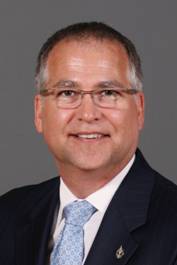
As the Minister of State for Science and Technology, my priority is the promotion of Canadian science, technology and innovation. Not only do they lead to important discoveries that benefit society, but they also are the foundation for greater productivity, competitiveness, job creation and economic growth.
For this reason, our government has been laying the groundwork to be able to leverage the benefits of science and technology.
In recent years, our focus has been on strengthening three key elements of Canada's innovation ecosystem: developing and recruiting world-leading research talent, modernizing research infrastructure across the country and stimulating private sector innovation. Since 2006, we have invested nearly $8 billion in new funding for science, technology and the growth of innovative firms—and our efforts are paying off.
Our institutes of higher education do well in international rankings, and we have developed a productive research community. Canada ranks first in the G7 for higher-education research spending, measured as a percentage of GDP. Our scientific research enterprise was also ranked fourth highest in the world by over 5,000 leading international researchers, according to the Council of Canadian Academies' 2012 report on the state of science and technology in Canada. This performance has been underpinned by funding provided by the Natural Sciences and Engineering Research Council of Canada, the Social Sciences and Humanities Research Council of Canada, and the National Research Council of Canada. As well, through Economic Action Plan 2012, we responded to the expert panel's Review of Federal Support to Research and Development (R&D), which offered recommendations on how to strengthen support for business R&D.
In 2011–12, the Natural Sciences and Engineering Research Council of Canada continued to maximize the government's return on its research investments by promoting partnerships between post-secondary institutions and Canadian companies through the Strategy for Partnerships and Innovation. The Strategy helps build the innovative capacity of Canadian companies by supporting outstanding research in priority areas. This year, two new program elements were added in the College and Community Innovation Program to boost research and development capacity at Canadian colleges. The first Discovery Frontiers initiative on the Arctic will capitalize on emerging opportunities where Canada can be a world-class research leader.
Through these measures, we have taken action to build a strong innovation system that ensures Canadian researchers continue to generate groundbreaking ideas and businesses have access to the knowledge, people and resources needed to market those ideas and create high-quality jobs.
It is my pleasure to join my colleague, the Honourable Christian Paradis, Minister of Industry, in presenting the 2011–12 Departmental Performance Report for the Natural Sciences and Engineering Research Council of Canada.
Gary Goodyear
Minister of State (Science and Technology)
Section I: Organizational Overview
Raison d'être
The Natural Sciences and Engineering Research Council of Canada (NSERC) is a leader in making Canada a country of discoverers and innovators for all Canadians. NSERC aims to maximize the value of public investments in research and development and to advance prosperity and quality of life in Canada. NSERC offers programs that support post-secondary research in the natural sciences and engineering (NSE) on the basis of national, peer-reviewed competitions.
NSERC supports partnerships and innovation to make it easier for industry to collaborate with academia and access the wealth of resources Canada's first-rate academic system has to offer.
NSERC develops the next generation of talented scientists and engineers through its scholarships and research stipends, and increases the visibility of Canadian research.
Responsibilities
NSERC is a departmental corporation of the Government of Canada created in 1978. It is funded directly by Parliament and reports to it through the Minister of Industry. NSERC's Council is composed of the President and up to 18 other distinguished members selected from the private and public sectors. The elected Vice-President is the Chair of Council and of its Executive Committee. The Council is advised on policy matters by various standing committees. The President of NSERC is the Chief Executive Officer. Funding decisions are approved by the President on the basis of recommendations made by peer review committees.
In fiscal year 2011-12, NSERC invested over $1 billion in postsecondary research and training in the NSE. NSERC's budget represents 10 percent of the federal government's expenditures on science and technology (S&T), and 20 percent of all university R&D funding in the NSE.
Mandate
The functions of NSERC, based on the authority and responsibility assigned to it under the Natural Sciences and Engineering Research Council Act (1976-1977, c.24), are to:
- promote and assist research in the natural sciences and engineering, other than the health sciences; and
- advise the Minister in respect of such matters relating to such research as the Minister may refer to the Council for its consideration.
NSERC's Governance Structure1
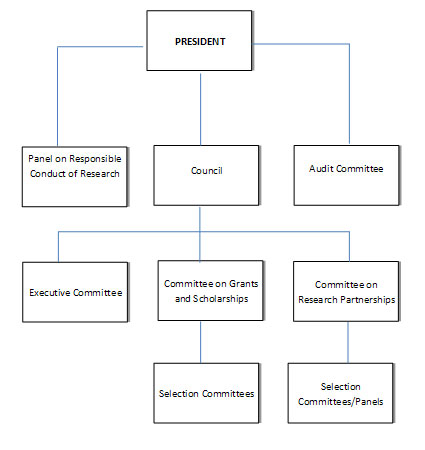
Strategic Outcome(s) and Program Activity Architecture (PAA)
In order to achieve its mandate, NSERC works toward the following strategic outcomes:
- People: Highly skilled science and engineering professionals in Canada - Building our human capital in the natural sciences and engineering by attracting and developing highly skilled science and engineering professionals.
- Discovery: High-quality Canadian-based competitive research in the natural sciences and engineering – Unleashing the power of our researchers to create knowledge and opportunities.
- Innovation: Knowledge and skills in the natural sciences and engineering are transferred to, and used productively by, the user sector in Canada – Seizing strategic opportunities for our country and realizing the benefits of research in industry and society.
The figure below highlights NSERC's priority area expenditures in 2011-12. In 2011-12, 81% of NSERC expenditures were in priority areas, up from 74% in 2010-11:

Source: NSERC database
NSERC grant expenditures by priority areas, 2011-12
Program Activity Architecture 2011-12
The chart below presents NSERC's Program Activity Architecture (PAA) in effect in 2011-12.
1.0 People Highly skilled science and engineering professionals in Canada |
2.0 Discovery High quality Canadian-based competitive research in the natural sciences and engineering |
3.0 Innovation Knowledge and skills in the natural sciences and engineering are transferred to and used productively by the user sector in Canada |
|---|---|---|
| Program Activities | ||
| 1.1 Promote Science and Engineering | 2.1 Fund Basic Research | 3.1 Fund Research in Strategic Areas |
|
Sub-Activities
|
Sub-Activities
|
Sub-Activities
|
| 1.2 Support Students and Fellows | 2.2 Support for Research Equipment and Major Resources | 3.2 Fund University-Industry-Government Partnerships |
|
Sub-Activities
|
Sub-Activities
|
Sub-Activities
|
| 1.3 Attract and Retain Faculty | 3.3 Support Commercialization | |
|
Sub-Activities
|
Sub-Activities
|
|
| * Programs involving two or more federal granting agencies. | ||
The following program activity supports all strategic outcomes within NSERC:
| 4.1 Internal Services |
|---|
|
Sub-Activities
|
Organizational Priorities
Summary of Progress against Priorities
| Priority | Type | Strategic Outcome(s) |
|---|---|---|
| Priority 1 - People Advantage: Inspire new generations of students to pursue careers in science and engineering, and provide them with the means to develop their full potential. | Ongoing |
|
|
||
| Priority | Type | Strategic Outcome(s) |
|---|---|---|
| Priority 2 - Knowledge Advantage: Lead the advancement of knowledge in science and engineering and ensure that Canadian scientists and engineers are leaders and key players in a global knowledge economy. | Ongoing |
|
|
||
| Priority | Type | Strategic Outcome(s) |
|---|---|---|
| Priority 3 - Entrepreneurial Advantage: Connect and apply the strength of the academic research system to addressing the opportunities and challenges of building prosperity for Canada. | Ongoing |
|
|
||
| Priority | Type | Strategic Outcome(s) |
|---|---|---|
| Priority 4 - Accountability: Demonstrate NSERC's accountability and how the results of its investments in Canadian research and training benefit Canadians. | Ongoing |
|
|
||
| Priority | Type | Strategic Outcome(s) |
|---|---|---|
| Priority 5 - Visibility: Increase visibility of Canadian research | Ongoing |
|
|
||
Risk Analysis
Operating Environment
While NSERC administers a significant budget, the agency's overall risk level, compared to other government entities, is considered low in terms of continuity of government operations and the maintenance of services to, and protection of interests of, the Canadian public. This assessment is supported in a 2007 Blue Ribbon Panel Report on Grants and Contributions which noted the rigorous system of oversight used by the federal granting agencies and deemed their record of performance to be high by international standards.
Operational Risks
In alignment with Treasury Board Secretariat guidelines and management frameworks, NSERC developed a Corporate Risk Profile in 2010-11 to formally identify, assess and mitigate corporate risks. In 2011-12, NSERC engaged in early activities to deliver on mitigation strategies against high risks identified in its Corporate Risk Profile (CRP) and took steps to incorporate an integrated approach to risk management.
The following table lists the five significant risks previously identified in the CRP, examples of mitigation measures already in place and a number of incremental controls proposed in the CRP to further address those risks. The table also identifies risks that have been downgraded due to the successful implementation of controls and mitigation strategies in 2011-12.
| Risks | Mitigation Strategies |
|---|---|
| 1) Human Resource Capacity The risk that the organization does not have or cannot recruit/retain the required human resources capacity (i.e., number and/or skill sets) to deliver its mandate effectively; |
Existing mitigation strategies include Human Resources annual reports, scorecards and a unique staffing policy. Incremental mitigation strategies developed in 2011-12 include a People Strategy to meet the people needs associated with delivering NSERC's business; the development of a recruitment strategy to attract staff with the required competencies; and implementation of performance management activities that integrate formal succession plans and leadership competencies, etc. |
| 2) Information Technology Innovation The risk that the organization does not adequately leverage technology to support its needs, to promote efficiency, or to innovate (e.g., services and processes); |
Existing mitigation strategies include a 5-year plan to replace hardware, a business plan process to identify areas for improving efficiency, as well as professional expertise in-house to support staff. Incremental mitigation strategies developed in 2011-12 include the development of an Information Management/IT Strategic Plan to proactively lever technology and improve the efficiency of internal operations and external client service. Gaps between NSERC's information management system operations and Treasury Board Policy were identified and have been corrected. Several activities were implemented to tackle inefficiencies and technology gaps within the organization's information management system. |
| 3) Operating Budget Management The risk that the organization is ineffective in monitoring operating budgets and making informed and/or accurate decisions; |
Controls already in place include online budget reports for salary and non-salary type expenditures and the establishment of responsibilities for contracting, procurement and expenditures as prescribed by the delegated financial signing authority. Incremental controls developed in 2011-12 include drafting a modernized corporate resource management framework, formal variance analyses for quarterly financial reporting and budget and resource management training modules for budget holders. |
| 4) Project Management Capability The risk that the organization does not have the required capabilities, tools or dedicated expertise to effectively manage key projects; and |
A project management framework, compliant with Treasury Board policies and managed by a full time Project Management Office, was implemented in early 2011. Projects are now managed through a structured stage-gate approach. As a result, Project Management Capability has been removed from the risk registry, as it no longer poses a risk to the organization. This risk is now being replaced by a new risk to monitor the use of the project management capability that is now in place. |
| 5) Sufficiency of Operating Funds The risk that allocated operating funding is not sufficient to support program/project delivery requirements. |
The rating of this risk was lowered due to additional operating funding available and enhanced resource decision-making supported by the modernization of the budget management framework and integrated planning. Additional mitigation strategies and controls developed in 2011-12 include building on integrated planning processes to enhance linkages between budgets and corporate/business plans, exploring tri-agency approaches as well as collaborating with other departments, agencies, and partners; and rationalizing, streamlining and modernizing NSERC's business model to gain efficiencies. |
Summary of Performance2
| Planned Spending | Total Authorities* | Actual Spending* |
|---|---|---|
|
* Excludes amount deemed appropriated to Shared Services Canada, if applicable. |
||
| 1,066.6 | 1,089.28 | 1,085.74 |
| Planned | Actual | Difference |
|---|---|---|
| 376 | 389 | 13 |
Summary of Performance Tables
| Strategic Outcome: 1.0 PEOPLE - Highly skilled science and engineering professionals in Canada | ||
|---|---|---|
| Performance Indicators | Targets | 2011–12 Performance |
| Percentage of population with higher education in the NSE vs. G8 countries. | Maintain or exceed current ranking (Canada was sixth in 20063). | Canada ranked 4th in percentage of population with first university degree in NSE vs. G8 countries in 2008. |
| Program Activity | 2010-11 Actual Spending |
2011-12 ($ Millions) | Alignment to Government of Canada Outcomes | |||
|---|---|---|---|---|---|---|
| Main Estimates |
Planned Spending |
Total Authorities* |
Actual Spending* |
|||
|
* Excludes amount deemed appropriated to Shared Services Canada, if applicable. ** The Canada Research Chairs program under PA 1.3-Attract and Retain Faculty was slightly underspent in 2011-12. These funds were transferred to Research Tools and Instruments under PA 2.2- Support for Research Equipment and Major Resources. |
||||||
| 1.1. Promote Science and Engineering | 11.93 | 5.55 | 5.55 | 5.55 | 5.22 | An innovative and knowledge- based economy |
| 1.2 Support Students and Fellows | 153.76 | 149.60 | 149.60 | 149.83 | 144.06 | An innovative and knowledge- based economy |
| 1.3 Attract and Retain Faculty | 161.12 | 152.90 | 152.90 | 152.57 | 137.20** | An innovative and knowledge- based economy |
| Total | 326.81 | 308.05 | 308.05 | 307.95 | 286.48 | |
| Strategic Outcome: 2.0 DISCOVERY - High-quality Canadian-based competitive research in the natural sciences and engineering | ||
|---|---|---|
| Performance Indicators | Targets | 2011–12 Performance |
| Average numbers of times that Canadian papers in the NSE are cited by other researchers (Average Relative Citation Factor of Canadian publications in the NSE - comparison with other countries). | Maintain top 20 world ranking (Canada was 16th in 20084). | Canada ranked 16th in 2011-12. |
| Program Activity | 2010-11 Actual Spending |
2011-12 ($ Millions) | Alignment to Government of Canada Outcomes | |||
|---|---|---|---|---|---|---|
| Main Estimates |
Planned Spending |
Total Authorities* |
Actual Spending* |
|||
|
* Excludes amount deemed appropriated to Shared Services Canada, if applicable. During the course of the year, NSERC will make program budget adjustments that sometimes result in actual spending exceeding total authorities at the program activity level only. ** Unused funds from other NSERC programs were transferred to Research Tools and Instruments under P.A. 2.2- Support for Research Equipment and Major Resources. |
||||||
| 2.1 Fund Basic Research | 369.06 | 358.44 | 358.40 | 363.38 | 357.53 | An innovative and knowledge- based economy |
| 2.2 Support for Research Equipment and Major Resources | 71.04 | 37.90 | 37.90 | 37.98 | 66.41** | An innovative and knowledge- based economy |
| Total | 440.10 | 396.34 | 396.30 | 401.36 | 423.94 | |
| Strategic Outcome: 3.0 INNOVATION - Knowledge and skills in the natural sciences and engineering are transferred to and used productively by the user sector in Canada | ||
|---|---|---|
| Performance Indicators | Targets | 2011–12 Performance |
| Percentage growth in the number of partner companies annually. | Greater than five percent per year. | Growth of 24% per year in 2011-12 and average annual growth of 13.5% over the past decade. |
| Program Activity | 2010-11 Actual Spending |
2011-12 ($ Millions) | Alignment to Government of Canada Outcomes | |||
|---|---|---|---|---|---|---|
| Main Estimates |
Planned Spending |
Total Authorities* |
Actual Spending* |
|||
|
* Excludes amount deemed appropriated to Shared Services Canada, if applicable. **During the course of the year, NSERC will make program budget adjustments that sometimes result in actual spending exceeding total authorities at the program activity level only. |
||||||
| 3.1 Fund Research in Strategic Areas | 108.14 | 116.46 | 116.50 | 116.34 | 107.68 | An innovative and knowledge- based economy |
| 3.2 Fund University-Industry-Government Partnerships | 122.03 | 168.64 | 167.10 | 179.05 | 184.68** | An innovative and knowledge- based economy |
| 3.3 Support Commercialization | 53.11 | 36.77 | 54.8 | 58.62 | 57.94 | An innovative and knowledge- based economy |
| Total | 283.28 | 321.87 | 338.40 | 354.01 | 350.30 | |
| Program Activity | 2010-11 Actual Spending |
2011-12 ($ Millions) | ||||
|---|---|---|---|---|---|---|
| Main Estimates |
Planned Spending |
Total Authorities* |
Actual Spending* |
|||
|
* Excludes amount deemed appropriated to Shared Services Canada, if applicable. |
||||||
| 4.1 Internal Services | 25.75 | 23.87 | 23.90 | 25.96 | 25.02 | |
| Total | 25.75 | 23.87 | 23.90 | 25.96 | 25.02 | |
Expenditure Profile
During the 2011-2012 fiscal year, NSERC spent $1,085.74 million to meet the expected results of its program activities and contribute to its strategic outcomes.
Spending increase – Through Canada's Economic Action Plan (CEAP), the federal government temporarily expanded the Canada Graduate Scholarships (CGS) program which supports Canada's top graduate students. This included $35 million over three years up to 2011-12 for the CGS program. Through CEAP, the federal government also provided $3.5 million over two years for an additional 600 graduate internships in science and business, delivered through the Industrial Research and Development Program (IRDI).The IRDI program creates opportunities for skilled graduate students and postdoctoral fellows, by linking them with businesses that foster and utilize their talents. The last of the funding received by NSERC as part of CEAP for the CGS and IRDI programs was spent in 2011-12.
Budget 2010 – The federal budget 2010 increased NSERC's annual budget by an additional $13 million per year, starting in 2010–11. This increase included $8 million per year to strengthen support for advanced research, and $5 million per year to foster closer research collaborations between academic institutions and the private sector through NSERC's Strategy for Partnerships and Innovation. This budget also provided $45 million over five years to the granting councils to establish the Banting Fellowships program to attract top-level talent to Canada and doubled the budget of the College and Community Innovation Program by an additional $15 million per year, starting in 2010–11.
Budget 2011 – In the 2011 federal budget, NSERC received $15 million per year to support outstanding research in the natural sciences and engineering fields, through the Strategy for Partnerships and Innovation. This budget included an additional $35 million over five years to support climate change and atmospheric research at Canadian post-secondary institutions, $53.5 million over five years to support the creation of 10 new Canada Excellence Research Chairs and $12 million over five years to select a Canada-India Research Centre of Excellence. NSERC also received $3 million in 2011-12 and $5 million per year starting in 2012-13 to support 30 new Industrial Research Chairs at colleges, and $12 million over five years starting in 2011-12 to support joint college-university research and development projects with promising commercialization potential through the Idea to Innovation program.
Spending decrease – NSERC experienced core budget decreases of $11.2 million in 2009-10, $23.3 million in 2010-11, and $34.7 million in 2011-12 and ongoing, as a result of the 2009 Strategic Funding Review (Budget 2009). The figure below illustrates NSERC's spending trend from 2009-2010 to 2011-2012. For the 2009-2010 and 2010-2011 periods, all figures appear as reported in previous Departmental Performance Reports.
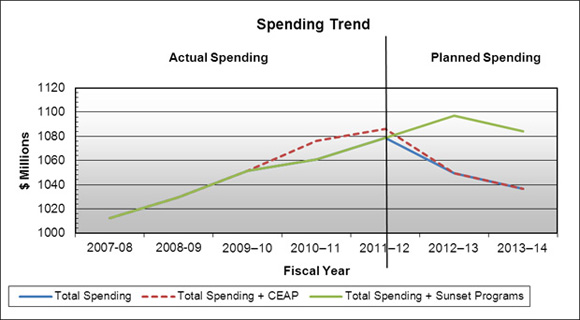
Source: NSERC
Spending Trend - NSERC
CEAP- Canada Economic Action Plan
Estimates by Vote
For information on the Natural Sciences and Engineering Research Council of Canada organizational Votes and/or statutory expenditures, please see the Public Accounts of Canada 2012 (Volume II).
An electronic version of the Public Accounts 2012 is available on the Public Works and Government Services Canada's Web site.
Section II: Analysis of Program Activities by Strategic Outcome
Strategic Outcome 1.0 People: Highly skilled science and engineering professionals in Canada
In 2011-12, NSERC supported 29,100 students and fellows at Canadian universities and abroad and provided programs to support the research of more than 11,000 university professors at Canadian universities and to attract leading global researchers to Canada. Through its investments in people, NSERC helps build a diverse, globally-competitive and technologically advanced knowledge-based economy for Canada.
Canada is currently 14th in the number of researchers per thousand employed relative to other Organization for Economic Cooperation and Development (OECD) countries place, ahead of Germany, Australia and the United Kingdom (Figure 2.0).
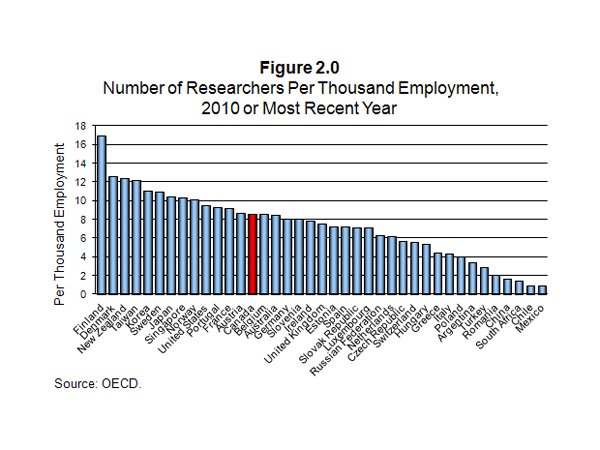
Number of Researchers Per Thousand Employment, 2010 or Most Recent Year
Program Activity 1.1: Promote Science and Engineering
Program Activity Description
This program activity stimulates the public’s interest in science, math and engineering and encourages the next generation of students to consider careers in these fields, helping to ensure that Canada has an ongoing supply of future discoverers and innovators. These activities are necessary as Canada has fewer university students enrolled in natural sciences and engineering disciplines and fewer PhDs graduating and working in these fields, relative to most OECD countries. NSERC awards grants to support activities of community-based organizations, museums, science centres and universities that stimulate the interest of young people and students and improve school performance in science and mathematics. In addition, NSERC offers several prizes that recognize and highlight Canadian achievements in training, research and innovation.
| Planned Spending | Total Authorities* | Actual Spending* |
|---|---|---|
|
* Excludes amount deemed appropriated to Shared Services Canada, if applicable. |
||
| 5.50 | 5.55 | 5.22 |
| Planned | Actual | Difference |
|---|---|---|
| 1 | 1 | 0 |
| Expected Results |
Performance Indicators |
Targets | Actual Results |
|---|---|---|---|
| Student interest in research in the sciences, math and engineering is encouraged. | Percentage of science promotion projects that successfully complete the planned activity. | Greater than 80 percent. | 86 percent. |
Performance Summary and Analysis of Program Activity
PromoScience - PromoScience grants allow organizations active in science promotion to reach many more Canadians, especially girls and aboriginal youth, to promote a science culture in Canada. PromoScience grants recipients from 2011-12 included the Alberta Women’s Science Network, the Nunavut Research Institute and Yukon College. Annual reports for PromoScience grants ending in 2011-12 indicated that 86% of the science promotion projects funded by the grants were successful. The profile of a 2011-12 PromoScience recipient located in Sackville, New Brunswick is featured below:
PromoScience Recipient – Tantramar Wetlands Centre Inc.
PromoScience funding supports a full-time Biologist/Wetlands Education Coordinator which has led to the expansion of programs and increased program days. The coordinator has developed, expanded and presented innovative science-based education programs that introduce youth to environmental science. NSERC funding contributed to the development of several new programs including water chemistry test kits which high school students use on site and in their classrooms, a mammal skull identification program involving hands-on analysis and classification, and a macro invertebrate biodiversity program for high school biology and environmental science classes. Many of the centre's other existing programs have benefited from NSERC support as well.
In addition to the programming, another key component to the centre's success is the involvement of high school volunteers or ‘Wetheads' in delivering the education programs. Referred to as "ambassadors for marsh conservation" by MacLean's magazine, these enthusiastic students engage younger students as well as their peers in the hands-on activities at the wetlands centre.
The addition of the full-time biologist position has allowed the Tantramar Wetlands centre to increase its annual reach from less than 2000 participants to more than 5000 per year.
Prizes - NSERC Prizes recognize outstanding individual Canadian researchers, research teams and students. They enhance the career development of outstanding and highly promising Canadian scientists and engineers and distinguish the sustained excellence of faculty members at Canadian universities. NSERC prizes include the E.W.R Steacie Memorial Fellowships and the Gerhard Herzberg Canada Gold Medal for Science and Engineering.
Every year, NSERC awards up to six Steacie Fellowships to enhance the career development of outstanding and highly promising university faculty who are earning a strong international reputation for original research.
In 2011-12, Dr. Ruth Signorell, Chemistry Professor at the University of British Columbia, was amongst one of the recipients. Dr. Signorell studies molecular aerosols, microscopic particles suspended in air composed of many molecules, which influence processes in the atmosphere that determine our climate. Aerosols are also a factor in pollution control, industrial processes and the delivery of medicine into the human body. Given their pervasiveness and impacts on human life, understanding the formation and behaviour of molecular aerosols is vitally important in fields as diverse as climate research and medicine.
Dr. Signorell's research will lead to greater understanding of how to control the formation of molecular aerosols, which could contribute to the development of nano-medicines. One of her team's research goals is to create encapsulated or coated particles to be used for controlled drug delivery. This emerging field has the potential to provide the means to deliver new therapies for various conditions, including cancer.
In 2011-12, NSERC awarded the Gerhard Herzberg Canada Gold Medal for Science and Engineering to Dr. Richard Peltier, a renowned University of Toronto physics professor who has helped pioneer Earth system science. His profile is featured below:
2011 Gerhard Herzberg Canada Gold Medal for Science and Engineering – Dr. Richard W. Peltier
Dr. Peltier is a renowned University of Toronto physics professor who has helped pioneer Earth system science to understand how the Earth works as an integrated system. He is highly cited and respected for his seminal contributions to geophysics, atmospheric physics and climate change research and internationally recognized for generating original understanding of ice-age geodynamics. His model of the changes in planetary shape caused by continental ice-sheet evolution employ sophisticated mathematical concepts to depict how our climate has evolved over the past 750 million years, and project what is likely to happen in the future if climate change continues
He is the founding Director of the University of Toronto's Centre for Global Change Science and a much-sought-after speaker. His extraordinary academic achievements have been matched by his leadership of three national research networks in Canada, and his mentorship of more than 30 doctoral students and an equal number of postdoctoral fellows.
Dr. Peltier's revolutionary work has earned him national and international awards including, in 2010, the prestigious Bower Award and Prize for Achievement in Science from the Franklin Institute in Philadelphia, which has also honoured such researchers as Marie Curie, Thomas Edison, Albert Einstein and Stephen Hawking. In 2002, he was awarded the Vetlesen Prize, which is often referred to as the equivalent of the Nobel Prize in the Earth sciences.
Program Activity 1.2: Support Students and Fellows
Program Activity Description
This program activity supports training of highly qualified people through programs of scholarships, fellowships and stipends. Support is provided to students during their research studies at all levels of university enrolment (undergraduate studies, master's and doctorate level graduate studies, and postdoctoral work), providing opportunities for recipients to develop technical and professional skills, and to experience enriched and varied research environments both within Canada and abroad. Scholarship programs aim to ensure that Canada is able to attract, retain and develop a talented, highly skilled workforce. The recipients of scholarship and fellowship awards are selected through peer reviewed national competitions.
| Planned Spending | Total Authorities* | Actual Spending* |
|---|---|---|
|
* Excludes amount deemed appropriated to Shared Services Canada, if applicable. |
||
| 149.60 | 149.83 | 144.06 |
| Planned | Actual | Difference |
|---|---|---|
| 29 | 32 | 3 |
| Expected Results |
Performance Indicators |
Targets | Actual Results |
|---|---|---|---|
| A supply of highly-qualified Canadians with leading-edge scientific and research skills for Canadian industry, government and universities | Percentage of students supported that are actively employed in Canada after graduation. | 75 percent. | 82 percent. |
| Average completion rates among NSERC award recipients vs. general NSE student population. | Completion rate 10 percent greater than NSE student population. | Completion rate was 17 percent greater than NSE student population. |
Performance Summary and Analysis of Program Activity
Since 1978, NSERC has supported more than 100,000 Canadians who received their degrees in natural sciences and engineering fields. In 2011-12, NSERC continued to provide direct financial support to students from the undergraduate to postdoctoral levels through key scholarship and fellowship programs, and indirect support through funding provided by NSERC-funded professors from their NSERC grants.
Based on the most recent data from the last cohort of NSERC-funded students, 97% of students completed the degree for which they received funding. This completion rate is 17% higher than that of unfunded students and 7% over the program activity's target (10%).
NSERC also directly supports the training of master's and doctoral students in natural sciences and engineering fields in industry and at universities through the Undergraduate Student Research Award (USRA), and the Collaborative Research and Training Experience (CREATE).
Undergraduate Student Research Awards - Undergraduate Student Research Awards (USRA) are meant to stimulate students' interest in research in the natural sciences and engineering and to encourage students to undertake graduate studies and pursue research careers in the natural sciences and engineering. The USRA provides funding for students to spend a four month work term at a university or industrial laboratory.
An evaluation of the USRA program covering the 10 year period from 1999 to 2009 was completed in 2011-12. The evaluation found that participating universities, researchers and companies expressed a strong need for the USRA program, since it encourages students to continue onto graduate studies and pursue research careers in the natural sciences and engineering.
The evaluation also found that the USRA program complements other undergraduate programs in Canada, rather than duplicating their efforts, since other programs have a more narrow focus and are smaller in scale than the USRA. The final evaluation report will be made public at the end of 2012-13.
Collaborative Research and Training Experience - The Collaborative Research and Training Experience (CREATE) supports teams of highly qualified students and postdoctoral fellows from Canada and abroad. CREATE encourages collaborative and integrative research approaches, addresses significant scientific challenges associated with Canada's research priorities and facilitates the transition of new researchers to the Canadian workforce.
An industrial stream was added to CREATE for the first time during the 2012 competition. To qualify under the new stream, applicants were required to demonstrate that their program committee included at least one industry collaborator and that the project would include internships in the private sector during 20 per cent of students' time.
NSERC conducts ongoing surveys of funded students at all levels. The table below highlights important achievements of NSERC-funded postgraduate students and fellows from on-going exit and career surveys:
| Postgraduate Students | |
|---|---|
| Short-term Outcomes* | Longer-term Outcomes** |
|
|
| Postdoctoral Fellows | |
| Short-term Outcomes* | Longer-term Outcomes** |
|
|
|
* Data from on-going exit surveys after completion of the NSERC scholarship or fellowship. ** Data from career surveys nine years after NSERC scholarship award or seven years after NSERC fellowship |
|
General macro-level economic outcomes for university graduates in the natural sciences and engineering also provide evidence for the positive outcomes of NSERC-funded students. In 2011-12, unemployment levels in the natural science or engineering occupations were considerably below national levels at 3% compared to general unemployment levels of 7.4%; employment opportunities in natural sciences and engineering have also continued to grow as the natural science and engineering labour force surpassed the 1.2 million mark in 2011-12 becoming one of the fastest growing occupational groups in Canada over the past 20 years. Furthermore, the average annual salaries for natural sciences and engineering professions in 2011-12 were 31% over the national average for all occupations (Figure 2.1).
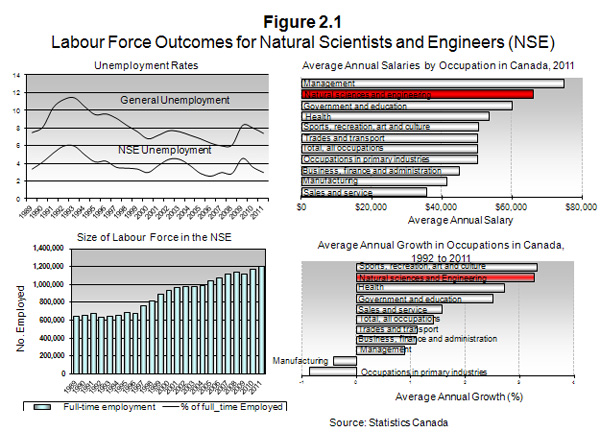
Labour Force Outcomes for Natural Scientists and Engineers (NSE)
Lessons Learned
Undergraduate Student Research Awards (USRA) – The USRA evaluation results showed that program participants perceive that their USRA experience provided them with a wide range of skills useful to their subsequent career and education, and that the most significant contribution of their training experience was exposure to research environments and knowledge about what a research career entails. The evaluation recommended that the USRA continue given its importance and relevance. The final evaluation report is expected to be published at the end of 2012.
Economic Action Plan Initiatives
Banting Fellowships - In 2011-12, NSERC, SSHRC and CIHR implemented the Banting Postdoctoral Fellowships Program as a single national Program with a dedicated tri-agency website. Results from the Banting Fellowships first competition were announced in 2011-12: 70 grants were awarded in total, 23 of which were awarded by NSERC.
The Banting Program’s Steering Committee has set a goal of having thirty per cent of applications from foreign candidates coming from abroad to Canada, to ensure that Canadian institutions can attract the best talent from abroad. To reach this goal, NSERC, the Social Sciences and Humanities Research Council, the Canadian Institutes of Health Research and the Department of Foreign Affairs and International Trade have enlisted the services of a non-governmental organization to help develop and execute an international marketing strategy for the program. The program is also being promoted via social media outlets such as Facebook and Twitter.
Program Activity 1.3: Attract and Retain Faculty
Program Activity Description
This program activity aims to attract and retain some of the world's most accomplished and promising researchers for faculty positions at Canadian universities. Researchers are awarded through a competitive peer review process to conduct leading edge research that improves our knowledge and quality of life, strengthens Canada's international competitiveness, and helps train the next generation of highly skilled people. These top researchers serve as magnets to other high calibre researchers and students to come to, or to remain in, Canada. Ultimately this helps to cultivate centres of world class research excellence at Canadian universities, and to brand Canada as a top destination for research.
| Planned Spending | Total Authorities* | Actual Spending* |
|---|---|---|
|
* Excludes amount deemed appropriated to Shared Services Canada, if applicable. ** The Canada Research Chairs program under PA 1.3-Attract and Retain Faculty, was slightly underspent in 2011-12. These funds were transferred to Research Tools and Instruments under PA 2.2- Support for Research Equipment and Major Resources. |
||
| 152.90 | 152.57 | 137.20** |
| Planned | Actual | Difference |
|---|---|---|
| 10 | 10 | 0 |
| Expected Results |
Performance Indicators |
Targets | Actual Results |
|---|---|---|---|
| Enhanced research capacity in science and engineering | Number of foreign-educated new applicants to NSERC's Discovery Grants program. | Greater than 100 per year. | 116 foreign-educated new applicants in 2011-12. |
| Number of NSERC-funded professors leaving the country. | Less than 100 per year. | 44 NSERC-funded professors left Canada in 2011-12. |
Performance Summary and Analysis of Program Activity
In 2011-12, there were 116 new foreign-educated applicants to NSERC's largest program, the Discovery Grants program who received both their bachelor's and Ph.D. degrees outside the country (Figure 2.2). This number is a good proxy for an overall evaluation of the "attraction" activity since the vast majority of new professors in the natural sciences and engineering apply to the Discovery Grants.

Number of Foreign Educated New Applicants to NSERC's Discovery Grants Program
Enhanced research capacity is dependent on retaining some of the world's most accomplished and promising researchers. As a result, NSERC tracks the reasons that grantees provide when they terminate their awards before the award end date. Only a small number of professors receiving NSERC support list "leaving the country" as the reason for terminating their award. The number of NSERC-funded professors leaving the country is an extremely small percentage of the over 11,000 professors receiving NSERC support each year. In 2011-12, this number was only 44 (Figure 2.3).

Number of NSERC-Funded Professors Leaving the Country
Canada Research Chairs - The Canada Research Chairs program has helped create a research environment that is conducive to the long-term retention and attraction of top researchers in Canada. A large number of Chair holders have been attracted from abroad and many top Canadian scientists have stayed in Canada as a result of the Chair support. The Chairs' research focuses on the federal government's priority research areas.
Lessons Learned
Canada Research Chairs - The 10th year Evaluation of the Canada Research Chairs Program was completed at the end of 2010-11 and was made public at the beginning of 2011-12. The evaluation found that the program is relevant, successful, and well-implemented and that there is a continued need for the program. The evaluation emphasized that responsibility for ensuring the program’s continued success needs to be shared jointly by the program and participating institutions. To follow-up on the evaluation report, the program’s management will engage institutions as partners in the delivery of the program, to help identify potential improvements that will maximize the program’s impact.
Economic Action Plan Initiatives
Canada Excellence Research Chairs - The Canada Excellence Research Chairs awards world-renowned researchers and their teams funding to establish ambitious research programs at Canadian universities. Thirteen out of the nineteen inaugural recipients of the Canada Excellence Research Chairs conduct research in the natural sciences and engineering. In 2011-12, these Canada Excellence Research Chairs launched their research programs in Canada to accelerate research in priority areas of the federal S&T strategy.
Strategic Outcome 2.0 Discovery: High-quality Canadian-based competitive research in the natural sciences and engineering
NSERC promotes and enables global excellence in discovery research. The knowledge generated through basic research provides a critical foundation for scientific and technological advances. Having a solid capacity for basic research across a broad range of fields in natural sciences and engineering ensures that Canada remains a leader in knowledge creation and globally competitive.
NSERC's discovery-based programs support long-term, ongoing programs of research, shorter-term research projects, the acquisition of research equipment and access to national research facilities. The Discovery Grants is NSERC's largest program and the primary program to support fundamental research leading to new knowledge and the training of the next generation - virtually every science and engineering student trained in Canada learns from NSERC-funded professors. Many of the researchers supported by the Discovery Grants devote their efforts to research in the priority areas of the Federal S&T Strategy.
The high quality and impact of Canadian research is evident in its ranking among top countries on the average number of times Canadian R&D publications are cited by other researchers. Citations are a measure of the potential use of a researcher's work by fellow researchers. Based on the number of citations received by scientific papers over the three years following the publication year, a standardized measure called the Average Relative Citation factor (ARC) is calculated for each country and international comparisons made.
The most recent data (2010) on the Average Relative Citation factor in the natural sciences and engineering shows Canada ranks 6th amongst G20 countries, ahead of Japan, China, India and Brazil (Figure 2.4).
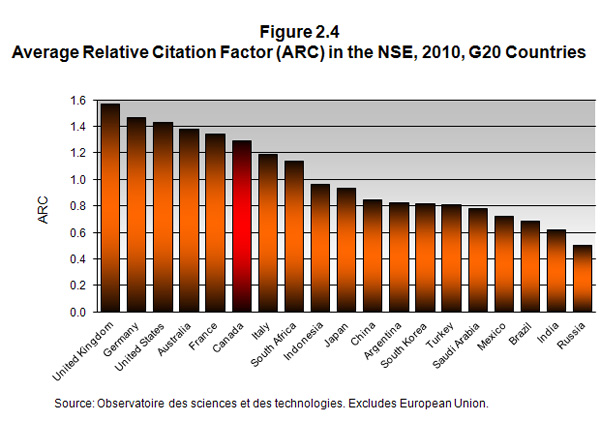
Average Relative Citation Factor (ARC) in the NSE, 2010, G20 Countries
Program Activity 2.1: Fund Basic Research
Program Activity Description
This program activity promotes and enables global excellence in discovery research in Canada. NSERC's discovery-based programs support long-term, ongoing programs of research as well as shorter-term research projects. In addition, NSERC provides substantial and timely additional resources to select researchers in order to accelerate progress and maximize the impact of their research program. Having a solid capacity for basic research across a broad spectrum of natural sciences and engineering disciplines ensures that Canada remains at the leading edge of knowledge creation. It also ensures that Canada can access and exploit S&T developments from other countries and forms the foundation for training the next generation of scientists and engineers.
| Planned Spending | Total Authorities* | Actual Spending* |
|---|---|---|
|
* Excludes amount deemed appropriated to Shared Services Canada, if applicable. |
||
| 358.40 | 363.38 | 357.53 |
| Planned | Actual | Difference |
|---|---|---|
| 53 | 56 | 3 |
| Expected Results |
Performance Indicators |
Targets | Actual Results |
|---|---|---|---|
| The discovery, innovation and training capability of university researchers in natural sciences and engineering is enhanced by the provision of support for ongoing programs of basic research | World ranking in number of natural science and engineering publications. | Maintain top 10 world ranking (Canada was 7th in 2008.)5 | Canada maintained its top 10 world ranking (Canada was 8th in 2010.) |
| Percentage of funds spent on training of students and postdoctoral fellows. | 35 percent. | Over 45 percent. | |
| Higher education expenditure on R&D (HERD) as a percentage of gross domestic product (GDP) compared to G8 countries. | Maintain current HERD world ranking (Canada was first in 2008 among G8 countries.)6 | Canada maintained its world ranking in HERD as a percentage of GDP (Canada was first in 2010 among G8 countries)7. |
Performance Summary and Analysis of Program Activity
NSERC's largest program, the Discovery Grants Program, helps build Canada's knowledge base by attracting talented researchers from around the world to Canadian universities. The Discovery Grants program is the mainstay of support for university-based research, as it provides funding for ongoing programs of research. To be funded, researchers must demonstrate research excellence and high productivity, as well as contributions to the training of highly qualified people. Over 45% of NSERC's Discovery Grants expenditures support students at the undergraduate, masters, and doctoral levels as well as postdoctoral fellows through stipends provided by NSERC-funded professors (Figure 2.5).
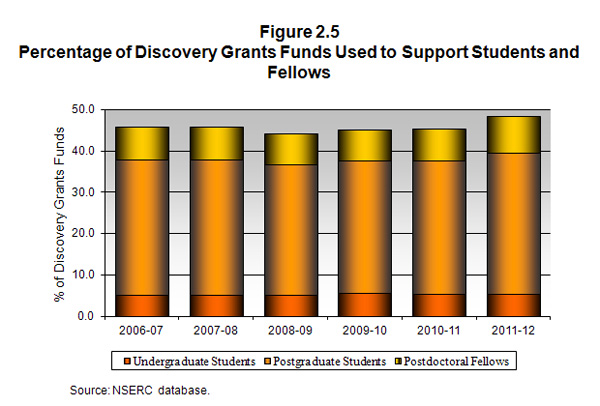
Percentage of Discovery Grants Funds Used to Support Students and Fellows
One of the first tangible outcomes of an investment in university research is a publication in a scientific or engineering journal. Since the vast majority of Canada's scientific and engineering publications are produced by university researchers, publications are a good indicator of the immediate outcome of NSERC research funding and can be used to benchmark our performance against the rest of the world.
In 2011-12, Canada maintained its world ranking in the number of natural sciences and engineering publications, dropping only one position from 7th to 8th place, but still within the top 10 countries in the world. The most recent data on scientific article production in the natural sciences and engineering shows that Canada ranks 8th in terms of number of publications in the natural sciences and engineering amongst the top 20 countries in the world (Figure 2.6).
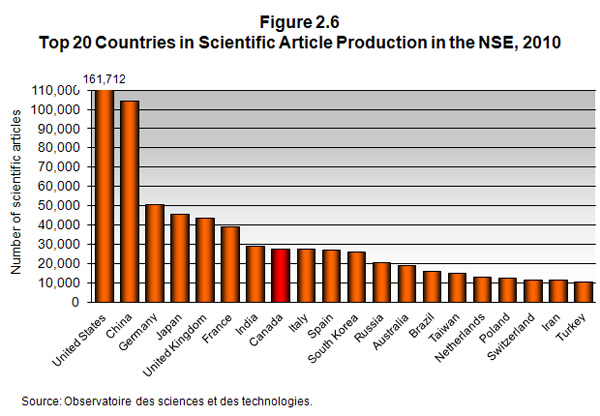
Top 20 Countries in Scientific Article Production in the NSE, 2010
In 2011-12, Canada also maintained its world ranking on higher education expenditure on R&D (HERD) as a percentage of gross domestic product (GDP), compared to other G8 countries. Based on the most recent data available (2010), Canada spends more on university research than all of its G8 competitors (Figure 2.7)
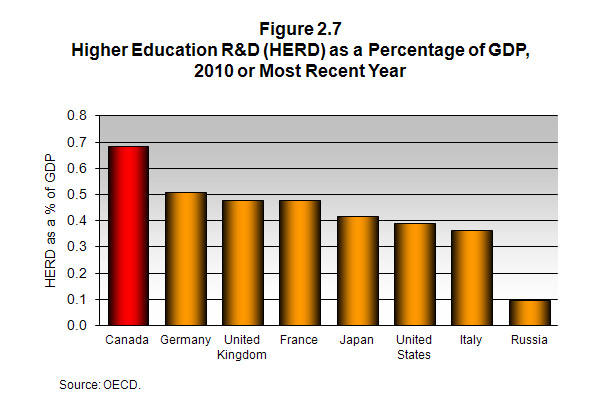
Higher Education R&D (HERD) as a Percentage of GDP, 2010 or Most Recent Year
Discovery Accelerator Supplements - The Discovery Accelerator Supplements (DAS) provide substantial and timely resources to a small group of researchers whose research proposals explore high-risk, novel or potentially transformative concepts that are likely to contribute to ground-breaking advances in their areas of research. The number of Discovery Accelerator Supplements available each year has been increased to 125 as previously planned. In 2011-12, NSERC awarded 125 supplements during the February 2012 competition. Eighty of the DAS were awarded were in areas aligned with NSERC's revised Strategic Target Areas: Environmental Science and Technologies, Natural Resources and Energy, Manufacturing, and Information and Communication Technologies which support priority areas.
Discovery Frontiers – In 2011-12, NSERC evaluated four full-proposals out of sixteen initial letters of intent during the first Discovery Frontiers competition, which was focused on Northern Earth System research. NSERC announced its first Discovery Frontiers grant in 2011-12. The grant was awarded to support the Arctic Development and Adaptation to Permafrost in Transition (ADAPT) project led by Université Laval ecologist Warwick Vincent. Over the next five years, he and a team of leading Arctic researchers will work at numerous sites across northern Canada to study the impact of changing permafrost and snowfall on landscapes, wildlife, northern communities and northern industries.
NSERC carried out a successful consultation with the research community in 2011-12 to develop topics for future requests for proposals under the Discovery Frontiers grants. Thirty-four topics were proposed as potential areas for the next call for proposals. NSERC will launch the second call for proposals for the Discovery Frontiers grants in 2012-13.
NSERC has also streamlined and consolidated its support for research in the Canadian North under the Northern Research Supplements, which is part of the Discovery Grants portfolio.
Economic Action Plan Initiatives
Climate Change and Atmospheric Research - In 2011-12, NSERC launched the Climate Change and Atmospheric Research (CCAR) initiative. This initiative will support climate change and atmospheric research at Canadian post-secondary institutions, as announced in the Federal Budget 2011. In 2011-12, NSERC launched the initiative by soliciting letters of intent on the following themes, identified in collaboration with Environment Canada:
- Understanding Earth system processes and their representation in weather, climate and atmospheric chemistry models;
- Advancing weather, climate and environmental prediction; and
- Understanding recent changes in the Arctic and cold region environments.
Program Activity 2.2: Support for Research Equipment and Major Resources
Program Activity Description
This program activity helps to support the acquisition, maintenance and operation of research equipment and major research resources. Funds are also used to facilitate researchers' access to major and unique research facilities in Canada and abroad. Grants are awarded through a competitive peer review process.
| Planned Spending | Total Authorities* | Actual Spending** |
|---|---|---|
|
* Excludes amount deemed appropriated to Shared Services Canada, if applicable. ** Unused funds from other NSERC programs were transferred to Research Tools and Instruments under P.A. 2.2- Support for Research Equipment and Major Resources. |
||
| 37.90 | 37.98 | 66.41** |
| Planned | Actual | Difference |
|---|---|---|
| 10 | 10 | 0 |
| Expected Results |
Performance Indicators |
Targets | Actual Results |
|---|---|---|---|
| The discovery, innovation and training capability of university researchers in the NSE is supported by their access to research equipment and major regional or national research facilities | Average number of researchers benefiting from equipment awards | Over 1,000. | 993 |
| Average number of researchers who benefit from each Major Resources Support award | Greater than 10. | 19 |
Performance Summary and Analysis of Program Activity
Research Tools and Instruments – Major research facilities and instruments are supported by the Canada Foundation for Innovation (CFI). However, researchers also need funding for small equipment to carry out their research. NSERC's Research Tools and Instruments (RTI), provides the funding necessary for purchasing small equipment.
In 2011-12, 993 researchers benefited from an NSERC RTI grant. This number is slightly under the program activity's target (over 1,000) (Figure 2.8). The number of researchers benefiting from an RTI award has dropped in recent years due to decreases in the budget available for the program. In 2011-12, NSERC transferred unused funds from other NSERC programs to RTI.
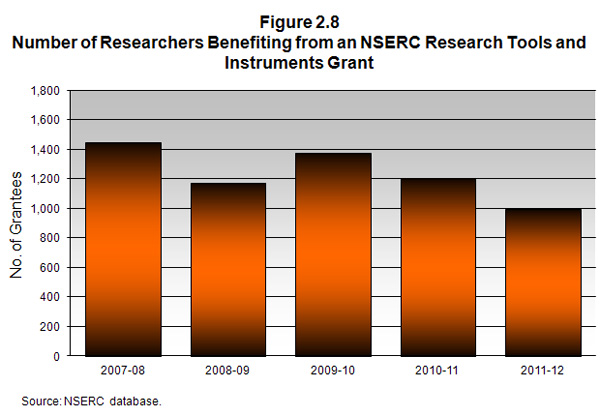
Number of Researchers Benefiting from an NSERC Research Tools and Instruments Grant
Lessons Learned
Major Resources Support - Major Resources Support (MRS) improves the international competitiveness of Canadian researchers and increases collaboration among them by facilitating access of Canadian researchers to over 40 experimental and thematic facilities.
The program also complements funding provided by Canada Foundation for Innovation (CFI) for several facilities, by providing necessary operating and maintenance support to fully utilize these facilities. There were 52 active MRS grants in 2011-12. The average number of researchers who benefited from each one of these MRS awards was 19 (Figure 2.9).
In 2011-12, NSERC also collaborated with CFI to develop shared application processes and jointly review applications for CFI's Major Science Initiatives Program. These collaborative efforts will ensure effective operational support of national research facilities and help eliminate any redundancy in application requirements between the two programs.

Average Number of Researchers per Grant Benefiting from an NSERC Major Resources Support Grant
Strategic Outcome 3.0 Innovation: Knowledge and skills in the natural sciences and engineering are transferred to and used productively by the user sector in Canada
NSERC's Research Partnerships Programs provide ways to connect and apply Canada's robust research capacity and the knowledge generated at Canadian universities and colleges to industry and to help industry develop new and improved technologies and processes to address the R&D challenges that they face.
NSERC provides Canadian-based companies access to the special knowledge, expertise and educational resources at Canadian postsecondary institutions and offers opportunities for mutually beneficial collaborations that result in industrial or economic benefits to Canada. Turning knowledge into innovative products and services forms the basis of a competitive economy.
In 2011-12, 2,361 firms partnered with NSERC, 450 more than in the previous year (Figure 2.10). The majority of the top 100 R&D firms in Canada are currently partners with NSERC. Industrial partners contribute financially to university research projects, scholarships and fellowships. In 2011-12, NSERC leveraged $155 million from industry for university-industry research projects and collaborated with more than 35 federal departments and agencies.

Number of Industrial Partners Participating in NSERC Programs
Program Activity 3.1: Fund Research in Strategic Areas
Program Activity Description
This program activity funds activities and research projects in selected areas of national importance and in emerging areas that are of potential significance to Canada. To take advantage of Canada's established excellence in research and innovation, and to build capacity in areas that are critical to the Canadian economy, NSERC invests in research areas that have been carefully selected as strategic priorities for the country. These investments support a range of activities such as research projects, networks and workshops. Funded activities share the common goal of connecting researchers with end users in order to enable the transfer or knowledge/technology and expertise to increase Canadian prosperity.
| Planned Spending | Total Authorities* | Actual Spending* |
|---|---|---|
|
* Excludes amount deemed appropriated to Shared Services Canada, if applicable. |
||
| 116.50 | 116.34 | 107.68 |
| Planned | Actual | Difference |
|---|---|---|
| 22 | 22 | 0 |
| Expected Results |
Performance Indicators |
Targets | Actual Results |
|---|---|---|---|
| Research and training in targeted and emerging areas of national importance is accelerated | Percentage of researchers applying for a strategic grant for the first time (or who have never applied in a specific area) of total number of applicants. | 5 percent. | 20 percent. |
NSERC invested about $108 million in strategic target areas, not including and additional $27 million in contributions from 580 partners. NSERC's strategic target areas were updated and re-launched in 2011-12. The updated strategic areas are: Environmental Science and Technologies, Information and Communications Technologies, Manufacturing and Natural Resources and Energy.
Strategic Network Grants – Strategic Network Grants fund large-scale, multi-disciplinary research projects in targeted research areas that require a network approach and that involve collaboration between academic researchers and Canadian-based organizations. The objective of Strategic Network Grants is to increase research and training in targeted areas that could strongly enhance Canada's economy, society and/or environment within the next 10 years. In 2011-12, NSERC awarded funding to four Strategic Networks including the NSERC Smart Microgrid Network (NSMG-Net).
The NSMG-Net is developing technologies in partnership with Canadian power utility companies that will establish Canada's next-generation electricity system, the Smart Grid, to allow unprecedented efficiencies in the development, application and use of Canada's energy resources. It will enable the Canadian power industry to achieve energy security, conservation and reduced carbon footprints.
Strategic Partnerships – Strategic Partnerships grants are designed to accelerate research in areas of national importance to Canada, where Canada can be a world leader. Strategic Project Grants, under the Strategic Partnerships umbrella, fund early-stage research projects in targeted areas that could strongly enhance Canada's economy, society and/or environment within the next 10 years. In 2011-12, 70 new Strategic Project Grants were awarded in the four target areas. In 2011-12, the number of new applicants to NSERC's Strategic Project Grant was 20% of the total number of applicants. There were 197 new applicants to NSERC's Strategic Projects Grants in 2011-12 (Figure 2.11).
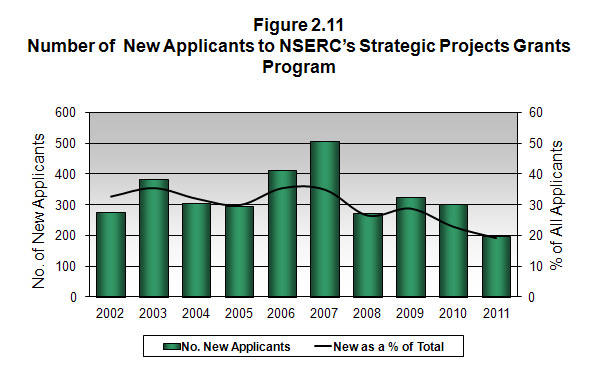
Number of New Applicants to NSERC's Strategic Projects Grants Program
Lessons Learned
A 10-year summative evaluation of the Strategic Projects Grants was completed in late 2011-12. The evaluation included a partial cost benefit analysis of the Strategic Projects Grants. Some highlights on results from the evaluation follow:
- Strategic Projects Grants continue to be relevant and meet an important need for both researchers and partners.
- The partial benefit-cost analysis demonstrated that benefits from five Strategic Projects cover about 1.4 times NSERC's investment in Strategic Project Grants.
- Almost all (95%) partners in the Strategic Projects Grants considered their collaborations with academic researchers to be successful.
- Research results were almost always transferred to partners and 73% of partners had used the results or planned to use the results of their research projects within the next two years after completion of the project.
- Thirteen of the projects funded through the Strategic Project Grants led to the creation of a spin-off company.
- On average, each Strategic Project Grant trains 15 highly qualified personnel.
Program Activity 3.2: Fund University-Industry-Government Partnerships
Program Activity Description
This program activity fosters collaborations between university researchers and industry, as well as other sectors, to develop and transfer new knowledge to Canadian-based organizations. A range of industry-driven programs aim to stimulate innovation in the Canadian economy and encourage greater science and technology (S&T) investment by the private sector. These partnership programs and projects address real world challenges that are relevant to industry, help build sustainable relationships between the two sectors and connect people and skills.
| Planned Spending | Total Authorities* | Actual Spending* |
|---|---|---|
|
* Excludes amount deemed appropriated to Shared Services Canada, if applicable. During the course of the year, NSERC will make program budget adjustments that sometimes result in actual spending exceeding total authorities at the program activity level only. |
||
| 167.1 | 179.05 | 184.68 |
| Planned | Actual | Difference |
|---|---|---|
| 60 | 59 | 1 |
| Expected Results |
Performance Indicators |
Targets | Actual Results |
|---|---|---|---|
| Mutually beneficial collaborations between the private sector and researchers in universities, resulting in industrial or economic benefits to Canada. | Increase in the number of industrial partners supporting and participating in university-industry collaborations. | Greater than 75 additional partners. | More than 260 additional industrial partners participated in 2011-12. |
| Partner satisfaction with research results. | 75 percent of partners indicating satisfaction through final reports and/or follow-up surveys. | 89 percent. |
NSERC's university-government partnership grants promote collaborations between university researchers and industry to develop new knowledge and expertise that can be transferred to Canadian-based companies. The Collaborative Research and Development grants and the Industrial Research and Development Fellowships give Canadian companies access to the unique knowledge and expertise available at Canadian universities, while training students in essential R&D skills needed by industry.
In 2011-12, 1,455 industrial partners participated in these programs. The number of industrial partners participating in NSERC's University-Industry Partnerships has grown since the launch of NSERC's Strategy for Partnerships and Innovation (Figure 2.12).

Number of Industrial Partners Participating in University-Industy Programs
In 2011-12, NSERC-funded researchers collaborated extensively with 37 other Federal departments and agencies, 64 provincial government departments and agencies, and 49 municipalities which all contributed funding to research projects. NSERC collaborates with federal partners such as the National Research Council, Health Canada, the Department of Fisheries and Oceans, the Department of National Defence, Canadian Space Agency, and the Canadian Food Inspection Agency, amongst many others.
Collaborative Research and Development - Collaborative Research and Development (CRD) grants support well-defined projects undertaken by university researchers and their private-sector partners. CRD awards cover up to half of the total eligible direct project costs, with the industrial partners providing the balance in cash and in kind. Industrial contributions related to the CRD Grants are an important indicator of the value NSERC's partners place on university research. On average, NSERC's industrial partners contribute more to CRD projects than NSERC. Industry partners have contributed, on average, 56% to CRD projects in the past 10 years, whereas NSERC's average contribution over the same period has been 44% (Figure 2.13).
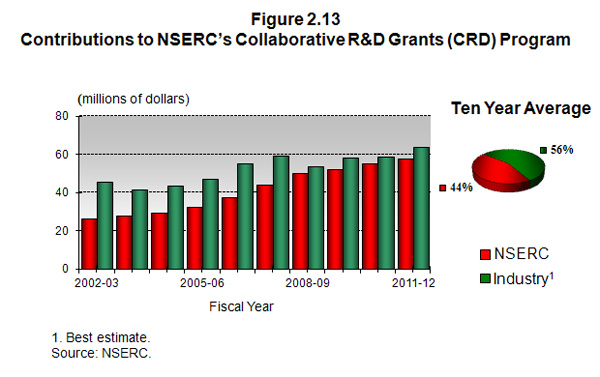
Contributions to NSERC's Collaborative R&D Grants (CRD) Program
In 2011-12, the number of CRD applications received increased by 13.4%; this increase can be attributed in part to NSERC's Engage grants, which connect researchers and companies and help develop new industry-academic relationships. Some of the initial connections made through Engage grants are translated into ongoing academic-industry research partnerships through programs such as the Collaborative Research and Development grants.
Industrial Research and Development Fellowships - The Industrial R&D Fellowships (IRDF) encourages business, particularly small companies, to hire postdoctoral researchers for a two-year period to undertake research and development (R&D) of importance to the company. This gives the company an opportunity to evaluate the postdoctoral fellows for potential long-term employment and gives the postdoctoral fellows the opportunity to gain relevant R&D experience at the company, making them more marketable for industry. NSERC's regional offices are increasingly involved in helping market these doctoral graduates to businesses in their regions.
In 2011-12, NSERC leveraged links with the Industrial Research Chairs and the Collaborative R&D grants to promote IRDF to more companies and increase awareness of IRDF amongst graduating doctoral students. These efforts resulted in a 25% increase in the total number of applications to IRDF in 2011-12. Promotion of IRDF by NSERC's regional offices has contributed greatly to this increase. The provinces of Ontario and Alberta saw the largest increase in applications last year with increases of 66% and 143%, respectively. In late 2011-12, NSERC and the Ontario Centres of Excellence partnered to jointly promote IRDF in Ontario and provide supplemental funding to attract and retain more doctoral graduates in that province.
Industrial Research Chairs - Industrial Research Chairs (IRC) assist universities in building on existing strengths to achieve the critical mass required for a major research endeavour in science and engineering of interest to industry, and to provide an enhanced training environment for graduate students and postdoctoral fellows by exposing them to research challenges unique to industry while giving them the opportunity for significant ongoing interactions with the industrial partners. IRCs are funded jointly by NSERC and industry. To be eligible to participate in the program, industrial partners need to demonstrate a strong commitment to a field of research relevant to industrial activity that is important to the Canadian economy.
In 2011-12, NSERC awarded IRC's in areas of importance to the Canadian economy, such as the natural resources sector. The profile below features a Chair holder appointed in 2011 who is working in this sector.
Mohamed Gamal El-Din – NSERC Industrial Research Chair in Oil Sands Tailings Water Treatment
Department of Civil and Environmental Engineering, University of Alberta
The NSERC Industrial Research Chair in Oil Sands Tailings Water Treatment will develop and advance economically viable solutions for sustainability in the oil sands industry. The overall goal of this IRC is to develop and assess different water treatment strategies and their applicability to oil sands operations for recycling or safely discharging oil sands process-affected water. The long-term objectives of this IRC include integrating fundamental and applied knowledge into actual water treatment and management options to be implemented by the oil sands industry. This research will lead to the development of highly effective treatment processes/strategies, resulting in the protection of the environment, wildlife, and human health.
Mohamed Gamal El-Din is a recognized leader in the national and international environmental engineering research communities, with significant and industrially relevant contributions in advanced treatment approaches for water and wastewater. The Chair is a joint venture between the University of Alberta, the oil sands industry, a water treatment utility company, a technology-development company, Alberta Innovates Energy and Environment Solutions, and Alberta Environment.
Industrial partners include: Syncrude Canada Ltd., Suncor Energy Inc, Shell Canada Ltd., Canadian Natural Resources Ltd., Total E&P Canada Ltd., EPCOR Water Services Inc. and IOWC Technologies Inc.
Lessons Learned
Industrial Research and Development Fellowships - An evaluation of the Industrial R&D Fellowships covering the period from 2000 to 2011 was completed in 2011-12. The evaluation found that the IRDF is relevant and meets an ongoing need. The IRDF was found to be particularly beneficial to private companies that have an R&D focus and to Small and Medium Enterprises, many of which have less than 100 employees or even less than 50 employees. The IRDF has resulted in positive impacts for host organizations, including:
- direct impacts on the products, services and competitiveness of host organizations (derived from the research carried out by the IRDF fellow).
- impacts on the R&D capability and R&D spending of the host organization.
- significant recruitment impacts for host organizations, encouraging them to hire PhD candidates in R&D, and facilitating recruitment of highly qualified personnel.
In many instances, hosting an IRDF fellow also enabled an organization to evaluate external technologies and to facilitate the transfer of new technology. It is not uncommon for IRDF projects to involve an element of collaboration that leads to increased awareness of R&D capabilities in Canadian universities amongst host organizations. The evaluation also found positive labour market outcomes for IRFD fellows. Most IRDF recipients remained employed in R&D positions following their fellowship and at least half were subsequently offered employment within the host organization. IRDF fellows also reported their participation in IRDF was useful career training.The final evaluation report containing specific recommendations and results will be published at the end of 2012.
Business-Led Networks of Centres of Excellence - Budget 2007 announced a $46 million investment over four years for the creation of the Business-Led Networks of Centres of Excellence program (BL-NCE). The goal of the BL-NCE program is to fund large-scale, collaborative, business-led networks that enhance private sector innovation and deliver economic, health, social, and environmental benefits to Canadians. An evaluation of the relevance and effectiveness of the BL-NCE program was completed in 2011-12. The evaluation found that the program is aligned with federal government priorities and the Federal S&T Strategy. The evaluation also found that there is an ongoing need for a program of the nature of the BL-NCE program, as it helps fill a gap in the innovation spectrum between ‘proof of concept' and ‘product development' by providing funding needed to undertake applied research that addresses business-specific needs and is led by the private sector. This funding would otherwise not be available or would be insufficient to fully address identified research needs. The final evaluation report will be made public in 2013-14. Consistent with evaluation findings, the government of Canada announced funding of $12 million per year in the federal Budget 2012 to make the program permanent.
Program Activity 3.3: Support Commercialization
Program Activity Description
This program activity supports the development of commercially promising technologies and promotes the transfer of knowledge and technologies to Canadian companies for commercialization. Strengthening Canada's record in commercialization is necessary to achieve business growth, job creation and a stronger, more resilient economy. By means of grants awarded through competitive peer review processes, NSERC aims to support the development of pre-competitive technologies and to help build the capacity of Canadian universities and colleges to work with industry and fuel economic growth. Federal investments serve to leverage significant amounts of private funding.
| Planned Spending | Total Authorities* | Actual Spending* |
|---|---|---|
|
* Excludes amount deemed appropriated to Shared Services Canada, if applicable. |
||
| 54.80 | 58.62 | 57.94 |
| Planned | Actual | Difference |
|---|---|---|
| 18 | 19 | 1 |
| Expected Results |
Performance Indicators |
Targets | Actual Results |
|---|---|---|---|
| The transfer of knowledge and technology residing in Canadian universities and colleges to the user sector is facilitated. | A set of nine university commercialization indicators collected by Statistics Canada. | An increase in the majority of the nine indicators. | Seven out of nine indicators have increased. |
NSERC's commercialization programs enhance the capacity of Canadian universities and colleges to transfer knowledge and technology from academic research laboratories to Canadian companies, and accelerate the pre-commercial development of promising innovations. In 2011-12, NSERC accelerated more than 61 university projects through proof of concept phase towards commercialization.
Statistics Canada conducts an annual survey of intellectual property commercialization in the university sector which indicates performance in technology and knowledge transfer activities in Canada. It is highly likely that the majority of the commercialization indicators presented in this survey are attributable to overall NSERC funding.
The latest data available for the survey at the time of this publication was for 2001-09. In the period from 2001 to 2009, most commercialization activities at Canadian universities have increased (Figure 2.14). Statistics Canada will no longer conduct this survey in the future.
Figure 2.14: Survey of University Intellectual Property Commercialization in Canada, 2001-2009
| Commercialization Activity | 2001 | 2003 | 2004 | 2005 | 2006 | 2007 | 2008 | 2009 |
|---|---|---|---|---|---|---|---|---|
| Invention disclosed | 1,105 | 1,133 | 1,432 | 1,452 | 1,356 | 1,357 | 1,613 | 1,428 |
| Inventions protected | 682 | 597 | 629 | 761 | 707 | 668 | 820 | 648 |
| New patent applications | 932 | 1,252 | 1,264 | 1,410 | 1,442 | 1,634 | 1,791 | 1,593 |
| Patents issued | 381 | 347 | 397 | 374 | 339 | 479 | 346 | 398 |
| Total patents held | 2,133 | 3,047 | 3,827 | 3,961 | 4,784 | 4,185 | 5,908 | 5,876 |
| New licenses | 320 | 422 | 494 | 621 | 437 | 538 | 524 | 537 |
| Total active licenses | 1,338 | 1,756 | 2,022 | 2,836 | 2,038 | 2,679 | 3,343 | 2,662 |
| Royalties from licensing ($M ) | $52.5 | $55.5 | $51.2 | $55.2 | $59.7 | $52.5 | $53.2 | $67.4 |
| Total spin-off companies | 680 | 876 | 968 | 1,027 | 1,103 | 1,174 | 1,242 | NA |
| Source: Statistics Canada |
Idea to Innovation - The Idea to Innovation (I2I) Grants provide funding to university researchers for R&D activities leading to technology transfer to new or already existing Canadian companies. The I2I supports R&D projects with recognized technology transfer potential by providing crucial assistance to university researchers in the early stages of technology validation and market connection. In 2011-12, NSERC funded 70 new Idea to Innovation awards. NSERC is exploring opportunities to align I2I with CIHR's Proof of Principle (POP) program.
Economic Action Plan Initiatives
College and Community Innovation - The College and Community Innovation (CCI) Program provides funding to colleges on a competitive basis, to strengthen their applied research capacity, and to promote applied research and technology transfer activities in collaboration with industry, in particular with small and medium-sized enterprises, in areas where colleges have recognized expertise and that meets local or regional needs.
In 2011-12, NSERC launched two new initiatives within the College and Community Innovation program as the result of new funding provided in the federal Budget 2011. These initiatives are the College University Idea to Innovation grants (CU-I2I) and the Industrial Research Chairs for Colleges (IRCC). The federal Budget 2011 provided $3 million in 2011–12 for the IRCC grants and a further $1 million in 2011–12 for the CU-I2I grants. The two new grant types were designed in consultation with the numerous college stakeholders, including the Association of Canadian Community Colleges, Polytechnics Canada, the Private Sector Advisory Board, the CCI Review Committee, Industry Canada, SSHRC and CIHR. Results from the first competition were announced in 2011-12
Section III: Supplementary Information
Financial Highlights
| Change % | 2011-12 | 2010-11 | |
|---|---|---|---|
| Total net liabilities | -9% | 12,106 | 13,279 |
| Total net financial assets | -25% | 4,296 | 5,721 |
| Departmental net debt | 3% | 7,810 | 7,558 |
| Total non-financial assets | -21% | 2,686 | 3,403 |
| Departmental net financial position | -23% | -5,124 | -4,155 |
| Change % | 2011-12 | 2010-11 | |
|---|---|---|---|
| Total expenses | 1% | 1,091,918 | 1,081,520 |
| Total revenues | - | 0 | 0 |
| Net cost of operations before government funding and transfers | 1% | 1,091,918 | 1,081,520 |
| Departmental net financial position | -23% | -5,124 | -4,155 |
Financial Statements
NSERC's audited financial statements for the year ending March 31, 2012 can be found on NSERC's website:
http://www.nserc-crsng.gc.ca/NSERC-CRSNG/Reports-Rapports/plans-plans_eng.asp
List of Supplementary Information Tables
Electronic supplementary information tables listed in the 2011–12 Departmental Performance Report can be found on NSERC's website:
http://www.nserc-crsng.gc.ca/NSERC-CRSNG/Reports-Rapports/plans-plans_eng.asp
- Details on Transfer Payment Programs
- Greening Government Operations
- Internal Audits and Evaluations
Section IV: Other Items of Interest
Organizational Contact Information
For further information about this report, please contact:
Barney Laciak, Manager
Corporate Planning and Reporting
Natural Sciences and Engineering Research Council of Canada
Telephone: 613-996-1076
E-mail: barney.laciak@nserc-crsng.gc.ca
[Footnotes]
1 In 2011, Canada's three federal research agencies, CIHR, NSERC and SSHRC, jointly created the Panel on Responsible Conduct of Research (PRCR) as part of a collaborative objective of ensuring a coherent and uniform approach for promoting responsible conduct of research and for addressing allegations of breaches of Tri-Agency Policies, consistent with the Tri-Agency Framework: Responsible Conduct of Research.
2 Performance tables presented in this section and in Section II-Analysis of Program Activities by Strategic Outcome include grants listed in the Details of Transfer Payment Programs tables. The difference between the performance tables and the Details of Transfer Payment Programs tables is due to the operational authorities for both planned and actual spending. The performance tables include the transfer payments amount, the personnel costs, the employee benefits plan costs and the non-salary (operating and maintenance) costs split by program activity and strategic outcome. The Details of Transfer Payment Programs tables only account for the transfer payments amount.
3 NSF Science and Engineering Statistics 2010, table 2-32: First university degrees, by selected region and country/economy: 2008 or most recent year, calculated per capita, G8 countries only.
4 Observatoire des sciences et des technologies, 2008.
5 Observatoire des sciences et des technologies, 2008.
6 OECD, Main Science and Technology Indicators database, May 2010.
7 OECD, Main Science and Technology Indicators database, January 2012.
